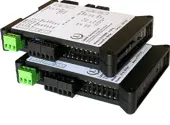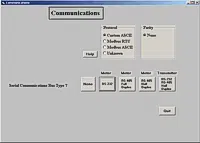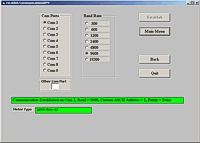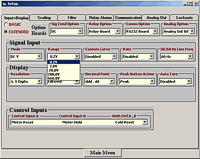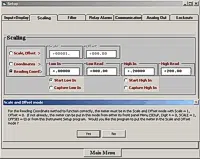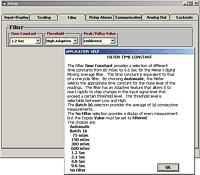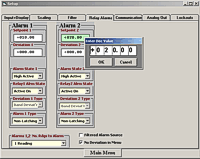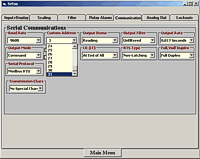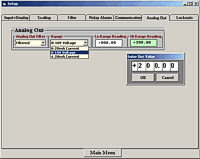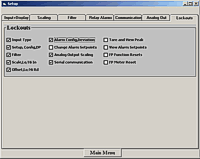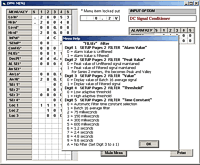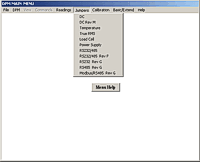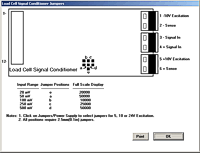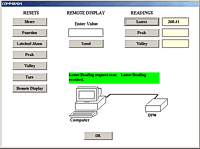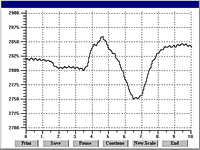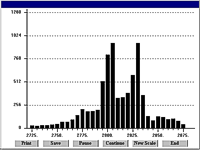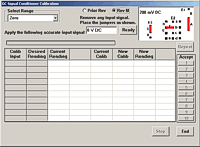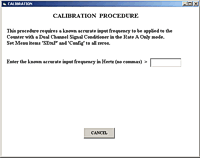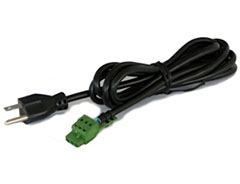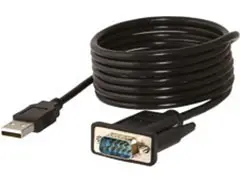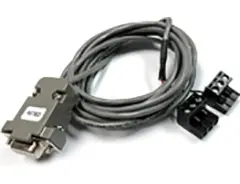Features
- 20, 50, 100, 250 and 500 mV full-scale input ranges
- Accuracy ±0.01% of reading ± 2 counts
- 4 or 6-wire hookup to avoid power supply and lead resistance effects
- All input ranges are user selectable and factory calibrated
- Up to 60 conversions per second, Ideal for peak or valley capture
- Digital span adjust from 0 to ±99,999, zero adjust from -99,999 to +99,999
- 4-20 mA, 0-20 mA, 0-10V or -10V to +10V transmitter output, (isolated)
- Analog output resolution 0.0015% of span, accuracy ±0.02% of span
- RS232 or RS485 serial data, Modbus or Laurel ASCII protocol (isolated)
- Dual 120 mA solid state relays for alarm or control (isolated)
- 5V, 10V, 12V, or 24V dc transducer excitation output (isolated)
- Power 85-264 Vac / 90-300 Vdc or 10-48 Vdc / 12-32 Vac (isolated)
- DIN rail mount housing, 22.5 mm wide, detachable screw-clamp connectors
- Operating temperature from -40°C to 70°C (-40°F to 158°F)
Optional - Extended allows up to 180 data points for custom curve linearization and a rate derived from consecutive readings.
Certificates of Compliance
The Laureate™ LT Series DIN rail analog transmitter with serial data communication and analog outputs for versatile connectivity.
The digitally programmable transmitter features two relays for alarm or control. The series offers exceptional accuracy of 0.01% of reading ± 2 counts, with high read rates at up to 60 or 50 conversions per second. The LT Series transmitters offer the same high performance, signal conditioning, and programmable features as Laureate digital panel meters, counters, and timers.The Laureate 4-20 mA, 0-20 mA, 0-10V or -10V to +10V and RS232/RS485 output transmitter for load cell or microvolt input is designed for use with load cells, strain gauges and microvolt input signals where exceptional sensitivity and stability are required. A most sensitive full-scale input range ±20 mV can be scaled internally to ±99,999 counts. The selected input range for the full 0-20 mA output span can be as wide as ±99,999 counts or as narrow as 150 counts, limited only by considerations of electrical noise and time constants of the programmable moving average digital filter. The unit's serial data is accurate to ±0.01% of reading ±2 counts in ratiometric load cell mode and ±0.01% of full scale in ±2 counts in absolute microvolt mode.
All signal conditioner board ranges are factory-calibrated, with calibration factors for each range securely stored in an onboard EEPROM. These factors can be scaled via software to accommodate external shunts, enabling field replacement of signal conditioner boards without necessitating recalibration of the associated transmitter. For optimal accuracy, factory recalibration is recommended annually. All Laurel Electronics instruments undergo factory calibration using the industry-leading Fluke calibrators, which are recalibrated yearly and certified traceable to national standards, ensuring the highest level of precision and reliability.
The optional extended Laureate computer board enhances Laureate transmitter by displaying rates derived from successive readings and enabling highly accurate custom curve linearization. For example, it can calculate liquid volume or flow rate in a horizontal cylindrical tank using levels from a 4-20 mA transmitter. Setup is straightforward: users input up to 180 data points into a spreadsheet or text file, and the computer calculates spline-fit segments, which are then downloaded to the transmitter for precise operation.
Laureate Transmitters are easily programmed with Laurel’s free Instrument Setup Software, downloadable from our website and compatible with Windows PCs, requiring a data interface board for setup.
High read rate of up to 50 or 60 conversions per second, the Laureate™ LT Series transmitter uses Concurrent Slope (US Pat. 5,262,780) analog-to-digital conversion to integrate signals over a full power line cycle (50 Hz or 60 Hz). This read rate enables peak and valley capture, real-time computer interfacing, and control applications. Peak and valley values are automatically captured and can be viewed using Laurel’s free Instrument Setup Software (compatible with Windows PCs) or transmitted as serial data.
Standard Hardware Features of Laureate LT Transmitters Include:
- Serial communications output, (isolated), RS232 or RS485 (half or full duplex), jumper selectable. Three protocols are user selectable: Modbus RTU, Modbus ASCII, or Laurel ASCII. Modbus operation is fully compliant with Modbus Over Serial Line Specification V1.0 (2002). The Laurel ASCII protocol is simpler than the Modbus protocol and is recommended when all devices are Laureates.
- 4-20 mA, 0-10V or -10V to +10V analog transmitter output, (isolated), jumper-selectable and user scalable. All selections provide 0.0015% resolution of output span and 0.02% output accuracy of a reading from -99,999 to +99,999 counts that is also transmitted digitally. Output isolation from signal and power grounds eliminates potential ground loop problems. Note that Ethernet data I/O is provided by Laurel's LTE series transmitters.
- Dual solid state relays, (isolated), for alarm or control. Rated 120 mA at 130 Vac or 180 Vdc.
- Selectable transducer excitation output, (isolated), user selectable 5V@100 mA, 10V@120 mA, 12V@100mA, or 24V@50 mA.
- Power 85-264 Vac, (isolated), low-voltage 10-48 Vdc or 12-32 Vac power is optional.
Digital signal filtering modes can be selected to ensure stable readings in electrically noisy environments.
- An unfiltered selection provides true peak and valley readings and aids in control applications.
- A batch average filter selection averages each 16 conversions.
- An adaptive moving average filter selection provides a choice of 8 time constants from 80 ms to 9.6 seconds. When a significant change in signal level occurs, the filter adapts by briefly switching to the shortest time to follow the change, then reverts back to its selected time constant. An Auto setting selects the time constant selection based on signal noise.
Two tare functions: auto-tare and manual tare. In auto-tare, an input line is grounded by an external pushbutton. This causes the current weight, which is normally the empty weight of the container to be stored in memory as an offset. In manual tare, the tare value can be entered manually via a control input pushbutton or using Laurel's free Instrument Setup Software.
Peak and valley values are automatically captured. These may be displayed via Laurel's free Instrument Setup Software, which runs on a PC under MS Windows or can be transmitted as serial data.
Two control inputs (CMOS/TTL levels, logic 0 = tied to digital ground, logic 1 = open) or dry contacts that can be set to control / activate 14 transmitter commands.
An (isolated) 5, 10, 12, or 24 Vdc excitation output is standard to power transducers or two-wire transmitters. Ratiometric operation, which automatically compensates for changes in the applied excitation, is jumper selectable for applications, such as bridges, where the signal to be measured is proportional to the excitation level.
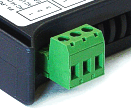
LT series DIN rail Transmitters & signal conditioners can be interfaced to a wide range of sensors and transducers using one of seven available plug-in signal conditioner boards. The transmitters duplicate the high performance (high accuracy and high read rate) and extensive programmable features of Laureate 1/8 DIN digital panel meters, counters, and timers. They utilize the same signal conditioners boards, much of the same firmware, and Laurel's free Windows-based Instrument Setup Software. They come in a compact DIN rail mount package with detachable screw-clamp connectors for easy wiring.
The LT series Transmitters feature isolated, user-selectable analog outputs (4-20 mA, 0-20 mA, 0-10V, or -10V to +10V), an RS232 or RS485 serial data interface, and dual 120 mA solid state AC/DC relays. Most models, except those with temperature or AC RMS signal conditioners, include an isolated 5, 10, 12, or 24 Vdc transducer excitation output.
Load Cell Transmitter Connections
 |
In 4-wire connection, the excitation and sense lines are tied together. The transmitter can make ratiometric corrections for supply voltage variations, but does not compensate for variations in lead resistance. This connection is often used with short cable runs. |
 |
In 6-wire connection, the sense lines are separate from the excitation lines, thereby eliminating effects due to variations in lead resistance. This allows long cable runs in outdoor environments with temperature extremes. |
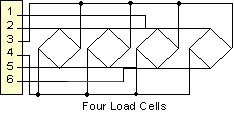 |
For large scales, up to four 350 ohm load cells can be powered by a single Laureate, whose excitation output is rated 120 mA at 10V. The excitation and sense points of the four bridges are connected in parallel. The load cell outputs will be averaged if the load cells have the same sensititivity in mV/V. |
Connecting Laureate LT Transmitters to a Local Area Network (LAN)
Up to 30 Laureate LT Transmitters and/or Digital Panel Meters can be configured for RS485 and daisy-chained to an LT Transmitter for seamless LAN integration. Alternatively, Laurel LTE series Ethernet transmitters can connect directly to a LAN via an Ethernet cable. Setup for both configurations is streamlined using Laurel’s free Instrument Setup Software, which simplifies node discovery and transmitter configuration.
Flexible Communication Options for LT Transmitters
Laureate Transmitters can be equipped with Laurel communication boards to support various interfaces and protocols. These include serial interfaces with ASCII or Modbus RTU protocols, and Ethernet interfaces with web access, ASCII, or Modbus TCP/IP protocols, ensuring versatile connectivity for your commercial applications.
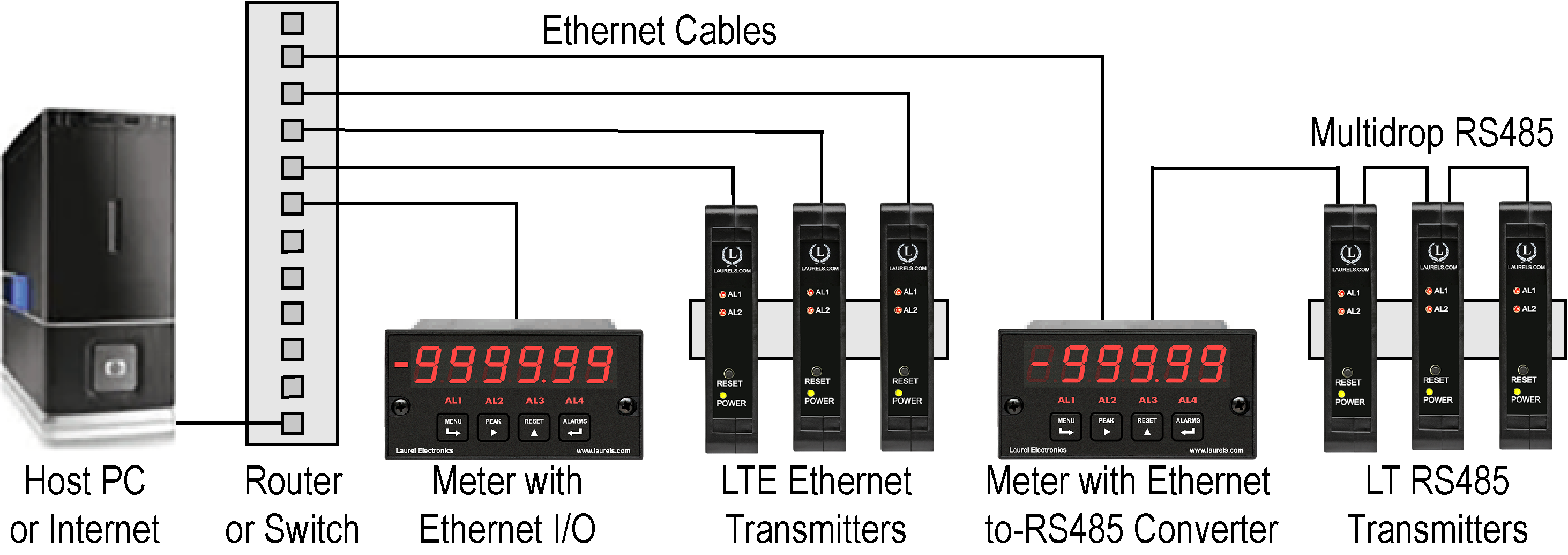
| LT Transmitter Signal Input & Function | Model Series | Analog Output | RS232 & RS485 | Dual Relays | |
|---|---|---|---|---|---|
| 1 | DC Input Voltage and Current | LT-DC |  |
 |
 |
| 2 | AC RMS Voltage or Current | LT-RMS |  |
 |
 |
| 3 | Process Voltage or Current | LT-P |  |
 |
 |
| 4 | Weighing Applications | LT-WA |  |
 |
 |
| 5 | Load Cell & Microvolt Signals | LT-WM |  |
 |
 |
| 6 | Thermocouple (Types J, K, T, E, N, R, S) | LT-TC |  |
 |
 |
| 7 | RTD Temperature | LT-RTD |  |
 |
 |
| 8 | Resistance in Ohms | LT-R |  |
 |
 |
| 9 | Frequency, Rate, Speed | LT-FR |  |
 |
 |
| 10 | Pulse Input Totalizer | LT-FR |  |
 |
 |
| 11 | Process Signal Totalizer | LT-VF |  |
 |
 |
| 12 | Sum, Difference, Ratio, Product of 2 Inputs | LT-FR |  |
 |
 |
| 13 | Batch Controller Pulse Input | LT-FR |  |
 |
 |
| 14 | Batch Controller Analog Input | LT-FR |  |
 |
 |
| 15 | On/Off Duty Cycle | LT-FR |  |
 |
 |
| 16 | Stopwatch Timing for Single Events | LT-FR |  |
 |
 |
| 17 | Average Time of Periodic Events | LT-FR |  |
 |
 |
| 18 | AC Phase Angle and Power Factor | LT-FR |  |
 |
 |
| 19 | Quadrature Position or Rate | LT-QD |  |
 |
 |
Load Cell, Strain Gauge and Microvolt input signal transmitter
| Analog Input | Range | Scaling | Input Ohms | Error at 25°C |
|---|---|---|---|---|
| Load Cell Input | ±20.000 mV | -99,999 to +99,999 zero adjust. 0 to ±99,999 span adjust. |
1 GΩ | ±0.01% of rdg ± 2 cts |
| ±50.0000 mV | ||||
| ±100.00 mV | ||||
| ±250.00 mV | ||||
| ±500.00 mV | ||||
| Microvolt Input | ±20.000 mV | 1 µV | 1 GΩ | ±0.01% of FS ± 2 cts |
| ±50.0000 mV | 2.5 µV | |||
| ±100.00 mV | 5.0 µV | |||
| ±250.00 mV | 12.5 µV | |||
| ±500.00 mV | 25 µV | |||
| Reading Resolution | 16 bits (65,536 steps) | |||
| Reading Accuracy | ±0.01% of reading ± 2 counts in ratiometric mode, ±0.01% of full scale ± 2 counts in absolute mode |
|||
| Update Rate, Max | 50/sec at 50 Hz, 60/sec at 60 Hz | |||
| Max applied voltage | 100 V | |||
| Recalibration: All ranges are calibrated at the factory. Recalibration is recommended every 12 months. | ||||
| A-to-D Conversion | ||||
| Technique | Concurrent Slope™ (Pat 5,262,780) | |||
| A-to-D rate | 60/s at 60 Hz, 50/s at 50 Hz | |||
| Output update rate | 56/s at 60 Hz, 47/s at 50 Hz | |||
| Display update rate | 3.5/s at 60 Hz, 3/s at 50 Hz | |||
| Accuracy | ||||
| Error at 25°C | 0.01% FS ± 2 counts (except 5A range) | |||
| Span tempco | 0.003% of reading/°C | |||
| Zero tempco | 0.1 count/°C | |||
| Noise Rejection | ||||
| CMR, DC to 60 Hz | 130 dB | |||
| NMR at 50/60 Hz | 90 dB with min filtering | |||
| Analog Output (standard) | ||||
| Output Levels | 4-20 mA, 0-20 mA, 0-10 Vdc, -10 to +10Vdc (user selectable) | |||
| Compliance, 4-20 mA | 10V (0-500Ω load) | |||
| Compliance, 0-10V | 2 mA (5 kΩ load or higher) | |||
| Output Resolution | 16 bits (65,536 steps) | |||
| Output Accuracy | 0.02% of output span plus conversion accuracy | |||
| Output Isolation | 250V rms working, 2.3 kV rms per 1 minute test | |||
| Excitation Output (standard) | ||||
| 5 Vdc | 5 Vdc ± 5%, 100 mA (jumper selectable) | |||
| 10 Vdc | 10 Vdc ± 5%, 120 mA (jumper selectable) | |||
| 12 Vdc | 12 Vdc ± 5%, 100 mA (jumper selectable) | |||
| 24 Vdc | 24 Vdc ± 5%, 50 mA (jumper selectable) | |||
| Output Isolation | 50 Vdc from signal ground | |||
| Ratiometric operation | Automatically compensates for changes in excitation level. | |||
| Dual Relay Output (standard) | ||||
| Relay Type | Two solid state relays, SPST, normally open, Form A | |||
| Load Rating | 120 mA at 140 Vac or 180 Vdc | |||
| Serial Data Output (standard) | ||||
| Signal Types | RS232 or RS485 (half or full duplex), jumper selectable | |||
| Data Rates | 300, 600, 1200, 2400, 4800, 9600, 19200 baud | |||
| Output Isolation | 250V rms working, 2.3 kV rms per 1 min test | |||
| Serial Protocols | Modbus TCP, Modbus RTU, Modbus ASCII, Laurel ASCII | |||
| Modbus Compliance | Modbus over Serial Line Specification V1.0 (2002) | |||
| RS232/485 Connector | Screw terminals for easy daisy chaining | |||
| Digital Addresses | 247 for Modbus, 31 for Laurel ASCII | |||
| Power Input | ||||
| Standard Power | 85-264 Vac or 90-300 Vdc | |||
| Low Power Option | 10-48 Vdc or 12-32 Vac | |||
| Power Frequency | DC or 47-63 Hz | |||
| Power Isolation | 250V rms working, 2.3 kV rms per 1 min test | |||
| Power Consumption at 24V | 1.5W typical, 3W with maximum excitation output | |||
| Environmental | ||||
| Operating Temp. | -40°C to 70°C (-40°F to 158°F) | |||
| Storage Temp. | -40°C to 85°C (-40°F to 185°F) | |||
| Relative Humidity | 95% at 40°C, non-condensing | |||
| Cooling Required | Mount transmitters with ventilation holes at top and bottom. Leave 6 mm (1/4") between transmitters, or force air with a fan. | |||
| Mechanical | ||||
| Enclosure | Rugged black polycarbonate housing material | |||
| Mounting | 35 mm rail per DIN EN 50022 | |||
| Dimensions | 129 x 104 x 22.5 mm case | |||
| Connectors | Detachable screw-clamp connectors for signal and power RJ45 jack for Ethernet | |||
| Tightening Torque | Screw terminal connectors: 5 lb-in (0.56 Nm) | |||
| Weight | Complete transmitter: 183 g (6.5 oz) | |||
| General | ||||
| Programming | Utilize Laurel's free Instrument Setup Software, which runs on a PC under MS Windows. | |||
| Security | Lockout options available using Laurel's free Instrument Setup Software. | |||
| Warranty | 3 years parts & labor | |||
| Recalibration: All ranges are calibrated at the factory. Recalibration is recommended every 12 months. | ||||
Transmitter Pinout
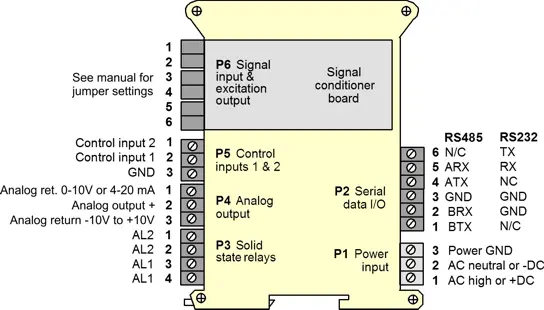
Free Instrument Setup Software for Series 2 Laureates
Free Downloadable Windows-based Instrument Setup (IS) software (Data Interface Board Required) for use with our programmable Digital Panel Meters, Scale Meters, Counters, Timers, Remote Displays, and Transmitters, are an easy method to set up Laureate 1/8 DIN digital panel meters, counters, timers, remote displays, and DIN-rail transmitters, as explained in the Instrument Setup Software Manual. Laureate 1/8 DIN instruments can also be set up from the front panel, as explained in their respective Owners Manuals. Instrument Setup software is of benefit whether or not the PC is connected to the instrument.
- When the PC is connected to the instrument, Instrument Setup software can retrieve the setup file from the instrument or open a default setup file or previously saved setup file from disk View Setup, then provides graphical user interface (GUI) screens with pull-down menus applicable to input, display, scaling, filtering, alarms, communications, analog output, and front panel lockouts. Fields that are not applicable to the instrument as configured are either left out or grayed out. Clicking on any item will bring up a detailed Help screen for that item. After editing, the setup file can be downloaded, uploaded to the instrument, or saved to a disk. The same setup file can then be downloaded into multiple instruments.
- When the PC is not connected to the instrument, the above GUI screens can be used to set up a virtual instrument. The setup file can then be saved to disk. Switching toView Menu then brings up a screen with the required front panel programming steps. This view can be printed out for use at the instrument site and to serve as a hard copy record.
Download Free Instrument Setup Software
Installation
Set User Account Control (UAC) of MS Windows to "Never notifiy me" so that Instrument Setup Software can create directories. The UAC change screen can be reached as follows:
- Under Windows 7, click on the Windows Start button in the lower left of the desktop and enter "UAC" in the search field.
- Under Windows 8, navigate to Control Panel, then to the "User Accounts and Family Safety" section, and click on "Change User Account Control Settings."
- Under Windows 10, click on the Windows Start button in the lower left of the desktop, then on "Settings", and enter "UAC" in the search field.
- Reboot your computer for the changed UAC setting to take effect.

RJ11-to-DB9 cable with rear view of DB9 connector to PC
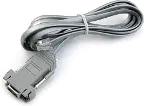
RS232 cable, meter to PC, P/N CBL01
Laureate 1/8 DIN Laureate instruments must be equipped with a serial communications board and be connected to the computer via a serial communications cable. The connection can be via RS232, RS485, USB or Ethernet. Following setup, the serial communications board may be removed from the instrument if desired. The wiring of the RS232 cable is illustrated above with end views of the two connectors.
Laureate LT Series transmitters come standard with a 3-wire serial interface, which can be jumpered for RS232 or RS485.
Laureate LTE Series transmitters come standard with an Ethernet interface.
Meter Setup Screens
Click on any of the reduced screens below for a full-size screen view, then click on the Back button of your browser to return to this page. The screens examples below are for a fully-loaded Series 2 Digital Panel Meter (DPM), which is connected to the PC via RS232. If the meter is a Series 1 meter (pre-2007), this is sensed by the software, and somewhat different screens are brought up. Please see Series 1 setup screens.











Meter Setup Utilities




From the Main Menu, click on Readings if your PC is connected to the meter. A pull-down menu then offers three choices: List, Plot and Graph.
- List presents the latest readings in a 20-row by 10-column table. Press Pause at any time to freeze the display. This is one method to capture peak readings.
- Plot generates a plot of readings vs. time in seconds. It effectively turns the DPM-PC combination into a printing digital oscilloscope.

- Graph generates a histogram where the horizontal axis is the reading and the vertical axis is the number of occurrences of readings. The display continually resizes itself as the number of readings increases.



Dimensions
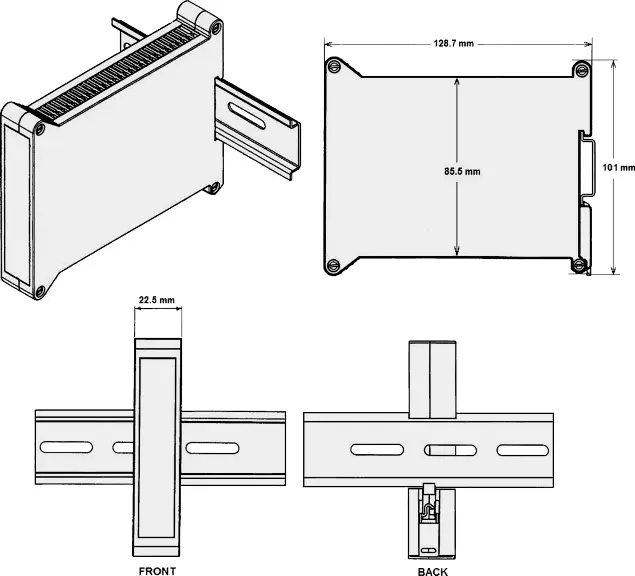
Dimensioned CAD assembly drawings in EPRT, STEP, x_t, .dwg, pdf file formats: Laureate-transmitter-case.zip (zipping prevents browser from opening CAD files as text files).
CBL02
USB-to-RS232 Adapter Cable
CBL04
RS232 Cable for LT Transmitters
Exploring LT DIN Rail Analog Transmitters with Serial Data Communication and Analog Outputs for Load Cell Strain Gauge Microvolt Input Signal
In the field of industrial automation and instrumentation, accurate measurement and signal handling are vital. A key device in this sector is the analog transmitter, particularly when managing inputs from load cell strain gauges. This article offers a detailed examination of the LT DIN Rail Analog Transmitter, focusing on its purpose, practical uses, and integration with load cells via serial data communication and analog outputs.
What is an LT DIN Rail Analog Transmitter?
The LT DIN Rail Analog Transmitter is a specialized tool engineered to transform faint microvolt signals from load cell strain gauges into reliable, usable analog and digital outputs. These transmitters are typically mounted on DIN rails, which are standardized metal supports designed to simplify the installation of industrial control equipment in electrical enclosures.
Key Features
-
Load Cell Strain Gauge Input:
Load cells function as sensors that detect force or weight, converting it into an electrical signal. The strain gauge within the load cell produces a microvolt-level signal based on the applied force, which the LT DIN Rail Analog Transmitter is designed to interpret accurately. -
Microvolt Signal Sensitivity:
The delicate microvolt signals from strain gauges are prone to noise and interference. The LT transmitter enhances these signals, ensuring precise measurements and consistent transmission. -
Analog Output:
After processing the microvolt signal, the transmitter generates a standard analog output, such as 4-20mA or 0-10V, which can be readily interpreted by industrial devices like programmable logic controllers (PLCs) for additional control and analysis. -
Serial Data Communication:
In addition to analog outputs, the LT DIN Rail Analog Transmitter supports digital transmission via serial data protocols such as RS-485 or RS-232. This capability enables real-time data tracking, remote adjustments, and seamless integration into advanced industrial networks. -
DIN Rail Mounting:
Built for easy installation on a DIN rail, this transmitter fits smoothly into existing control panels and electrical enclosures, with its standardized mounting system streamlining wiring and upkeep.
Applications
LT DIN Rail Analog Transmitters are extensively utilized in industries where precise weight or force measurement is paramount. Notable applications include:
- Industrial Weighing Systems: Employed in conveyor systems, hoppers, and batching operations to monitor and regulate material weight.
- Force Measurement in Manufacturing: Utilized in equipment like presses, tension analyzers, and material testing units for accurate force assessment.
- Process Control: Indispensable in processes requiring detailed oversight of force or weight, such as chemical blending or food production.
Advantages of Using an LT DIN Rail Analog Transmitter
-
High Precision: The capability to amplify and process microvolt signals ensures accurate measurements, essential for tasks like material testing or fine-scale weighing.
-
Adaptable Communication: The combination of analog outputs and serial data communication allows the transmitter to connect with a broad spectrum of industrial devices and systems.
-
Effortless Installation: The DIN rail mounting design simplifies integration into existing control setups, enhancing installation efficiency.
-
Durability: Constructed to perform reliably in industrial settings, these transmitters maintain robust operation even in challenging environments.
Conclusion
An LT DIN Rail Analog Transmitter with serial data communication and analog outputs is a cornerstone component in industrial automation, especially for handling low-level signals from load cell strain gauges. Its ability to enhance, convert, and transmit these signals ensures precise measurements throughout industrial processes, boosting operational effectiveness and accuracy. Whether applied in manufacturing, process management, or material evaluation, these transmitters are integral to the advancement of modern automation systems.
Where is an LT DIN Rail Analog Transmitter with Serial Data Communication and Analog Outputs for Load Cell Strain Gauge Microvolt Input Signal Used?
In industrial and scientific settings, accuracy and dependability are crucial, particularly when managing sensitive measurements from load cells and strain gauges. The LT DIN Rail Analog Transmitter, equipped with serial data communication and analog outputs, is a specialized device crafted to process microvolt input signals from these sources. This section outlines the primary areas of use, highlighting its substantial impact across various sectors.
1. Industrial Automation and Process Control
- Material Weighing and Batching Systems: Load cells are commonly used in industrial environments to measure weight with high accuracy. The LT DIN Rail Analog Transmitter transforms the subtle microvolt signals from load cells into practical analog outputs and digital data, which integrate with control systems. This is essential for material weighing and batching, ensuring consistent product quality.
- Force Measurement in Manufacturing: In manufacturing fields like automotive and aerospace, precise force measurement is vital. Strain gauges monitor force, pressure, or tension in components, and the transmitter processes these faint signals, providing outputs to control systems to keep forces within safe limits, protecting equipment and products.
2. Laboratory and Research Applications
- Structural Testing: In civil engineering labs, strain gauges assess material structural integrity. The LT DIN Rail Analog Transmitter reliably transmits these minute signals to data acquisition systems, enabling detailed stress and strain analysis.
- Material Fatigue Testing: For materials tested under repeated loads, strain gauges measure responses over time. The transmitter’s reliable analog and serial data outputs are key for gathering comprehensive data on material behavior under stress, aiding in developing more resilient products.
3. Weighing and Scale Systems
- Commercial Weighing Systems: In food processing, logistics, and packaging industries, precise weight is critical. Load cells paired with LT DIN Rail Analog Transmitters deliver accurate weight data, supporting packaging control, labeling accuracy, and product consistency.
- Vehicle Weighing Systems: For weighbridges and axle weighing, the transmitter ensures accurate conversion and transmission of load cell signals to monitoring systems, aiding compliance with weight regulations and preventing vehicle overloading.
4. Energy Sector
- Wind Turbine Monitoring: Strain gauges in wind turbines track blade and structural strain. The LT DIN Rail Analog Transmitter processes these signals for real-time monitoring, preventing structural failures.
- Pipeline Monitoring: In the oil and gas industry, strain gauges monitor pipeline integrity. The transmitter converts microvolt signals into data to detect leaks or weaknesses, enhancing safety and reliability.
5. Medical Equipment
- Prosthetics and Orthotics: Strain gauges in medical devices measure forces on prosthetics and orthotics. The transmitter ensures accurate data transmission to monitoring systems, enabling fine-tuning for optimal performance and comfort.
- Biomedical Research: In human movement or load-bearing studies, strain gauges monitor joint or limb forces. The transmitter converts these signals into analyzable data, advancing biomechanical understanding.
Conclusion
The LT DIN Rail Analog Transmitter with serial data communication and analog outputs for load cell and strain gauge microvolt input signals is a vital resource across multiple industries. Its expertise in processing and transmitting delicate signals makes it indispensable for industrial automation, structural testing, energy management, and medical research. As the need for precision and reliability increases, the importance of these transmitters will continue to grow, driving technological and safety innovations.
Less Information.








